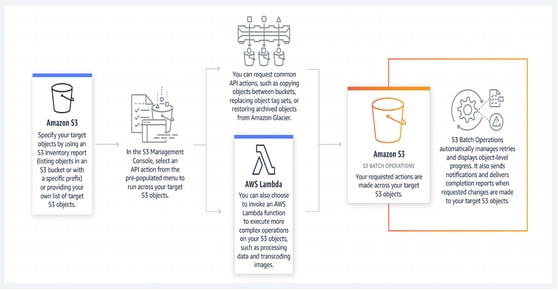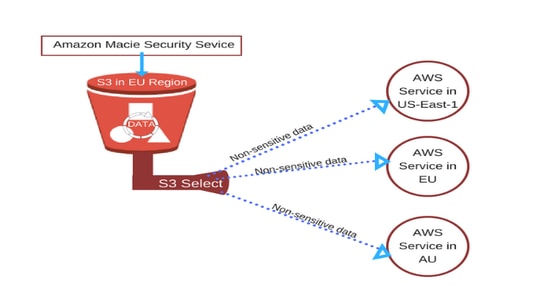
Amazon s3
Amazon Simple Storage Service
Amazon Web Services shortly called as AWS. If you are technically crisp, you will not require the expanded definition of web services. But for those who can’t get it right, here is an easy way to understand.
Amazon web services, found and launched in 2006, by their parent company Amazon.com to carry out their online retail operations. It is a subsidiary firm established to take care of the IT operations, software infrastructure, and other inevitable technical advancements. Simple terms; it is like an in-house IT team who can do anything for Amazon.com, but later opened doors for other vendors.
It is a comprehensive, cloud computing platform, providing the following services as offerings.
- Infrastructure as a service (IaaS) – includes software and hardware
- Platform as a service (PaaS) – a platform where one can develop and run applications
- Packaged software as a service (SaaS) – software run in online, don’t need to install
Again, the services are over the internet, so it reduces operating costs. In the cloud computing platforms, you pay only for the services you use, limiting the expense of business operation and increasing the efficiency & scalability.
Amazon Web Services includes
- Amazon Elastic Compute (EC2)
- Amazon Simple Storage Service (S3)
- Amazon Relational Database
- AWS Migration Hub
- Amazon Virtual Private Cloud
- AWS Command-Line Interface
- AWS Config
- AWS Cloud Formation
- AWS Directory Service
- Amazon Elastic MapReduce
- Amazon Kinesis
- Amazon QuickSight
- Amazon AI
- AWS Mobile Hub
- Amazon SES
- Amazon WorkDocs
- AWS Greengrass
Amazon S3 or AWS S3 or Amazon Simple Storage Service
The name tells half of the story already. As, it states, AWS S3 is a storage platform on a cloud. They designed it to do online backing up, storing applications and archiving data. S3 is developed with a limited set of features like a minimum viable product, meant to do maximum functionality under minimal core features.
How they are offering it?
Amazon offers the object storage service through a web-based cloud storage platform. It means any industry irrespective of nature, can depend reliably on AWS S3 for its storage of mobile applications, web applications, software, products, enterprise applications, IoT, big data analytics. You can protect, archive and manage huge data of your firm’s technical and non-technical applications with simple accessibility.
How S3 works?
Object-based storage means, it will store your data as an object. Example if you are uploading your mobile application, you will have files in a format of.apk, design files in.jpg and various other Android & iOS modules. So it stores each of them as an object with an ID when you want to access them, it retrieves them using the object ID. In the block cloud storage, developers access the data with REST API.

Amazon uses this model to run its own websites and the applications depending on them. Also, it offers the same S3 storage service to the subscribers of AWS. The storage space it offers to upload, store and download any file or object is 5TB in size. A single upload, the maximum largest file you can store is 5 GB.
Amazon uses this model to run its own websites and the applications depending on them. Also, it offers the same S3 storage service to the subscribers of AWS. The storage space it offers to upload, store and download any file or object is 5TB in size. A single upload, the maximum largest file you can store is 5 GB.
Amazon Storage Classes S3
Amazon Storage Classes are classified into the following
- S3 Standard
- S3 Intelligent-Tiering
- S3 Standard-IA
- S3 One Zone-IA
- S3 Glacier
- S3 Glacier Deep Archive
Now in detail on each class,
S3 Standard
This storage class is useful to the people who frequently access the data. S3 Standard storage class has low latency and high throughput. Amazon developers have designed the storage class for dynamic websites, high content websites or applications, big data analytics, cloud distributions, gaming websites, and content distributions.
S3 Intelligent-Tiering
If you are not sure about how frequently you will access the data (A.K.A the object), S3 intelligent tiering will take care of placing your objects. Let us say if you have both frequently accessing data and non-frequently accessing data. So, the frequently accessing objects will be placed in the frequent access tier by automatic optimization. The less accessed objects will be placed in the infrequent access tier. The intelligent tiering can automatically move the object to the frequent access tier if you retrieve the objects often or move them to the infrequent access tier if you don’t use them often. There is no additional retrieval fee or transfer fee for this tiered model.
S3 Standard-IA
It is for infrequent access but the access needs a rapid accessibility process. Due to the dynamic requirements of this tier, S3 Standard IA has high durability and high throughput. This combination is suitable for long-term storage and disaster recovery file. Compared to other storage classes the cost is low per Gb.S3
S3 One Zone-IA
The storage class is exactly the same functionality of S3 Standard-IA but offers 20% less cost. Unlike the other storage classes, they store the objects in a single AZ class. Suitable for low-cost storage, who looks for rapid access to infrequent data usage.
S3 Glacier
Least expensive option among the storage classes. It is designed for archival storage purposes. The storage class doesn’t offer any cross-tiering options to other data storing options because it takes longer to access the data.
S3 Glacier Deep Archive
It can be also considered as one of the subclasses of S3 Glacier. Both of them have the same core-functionality but the industry S3 Glacier Deep Archive serves is different. The storage class is tailored for Healthcare, Financial industry, and Accounting enterprise solutions
What is Amazon S3 bucket?
Amazon S3 bucket is the storage file. It is like a file folder, where you can store different kinds of files into a single region. They also contain the data and meta-data about the stored objects. S3 buckets limit the number of objects uploaded. Customers can manage and configure the S3 bucket.
Core Competencies
Amazon S3 has many features that will unlock the complete potential of the cloud storage platform. But Amazon claims the following two as their strong competency area which makes them stand out of the competition in the cloud-based storage services.
Durability
Amazon supports a 99.999999999% (11 9’s) of durability to the objects stored. The security compliances of AWS support high monitoring and security certifications to the administrators.
Data Transfer
AWS S3 allows you to transfer large amounts of data to S3 with public internet access S3 API’s. There is Amazon Private Connect for a secure, private connection of data, which is essential for enterprises. And also for the long distant data transfers, you use the S3 along with Amazon S3 Transfer Acceleration. Also, there is AWS Snowball which helps for physical transfer of the data to the data center directly at a large quantity.
Integrability
S3 helps users to integrate other AWS with S3. Example: a data analyst can take query by integrating the S3 with Amazon Data Athena.
Benefits of AWS S3
Cost Effective
AWS offers a low-cost storage service comparatively to the other cloud computing storage platforms. The policies let you set to migrate the data automatically to standard-infrequent access. Also, if you leverage the integration of Amazon Glacier along to your S3, you can reduce the cost further. Hosting your application on your server is expensive; it is a fixed price. You end paying even if you don’t use the service—can lead to face higher expenses. But thanks to the Pay-as-you-go model pricing structure, it helps you to pay only for the services you use.
Durability/Availability
As we discussed earlier, in the core competencies of S3, durability is 99.999999999% (11 9’s). Amazon is pretty much confident in the availability of its storage platform close to 100%. While hosting your own server, you may face sometimes hard failure like downtime. It leads to traffic distortion because of your site unavailability.
Amazon S3 offers your data protection and availability against hardware failure and power problems. S3 uses replicas to cover when there is downtime. If there is a question of issues on the server downtime, the replicas will cover them up and keeping your data and applications available to 99.999999999% (11 9‘s).
Simple Management
S3 data management is easy and will not require a higher complex technical knowledge. The key feature of the management is a data-driven approach for data security, storage optimization, and data management. This also makes the data transfer easy and simple. We also went through the various integrations S3 offers for the data center. While hosting your own server, transferring your data will be time-consuming and you also need to purchase another storage for your data.
Security
Amazon offers various reliable security measures that your own server limits. When a file is uploaded, the S3 console stores them as an object with the ID number and it automatically encrypts them with SSL protection. But this high-security compliance allows the AWS S3 to integrate and perform other security monitoring measures linked with CloudTrail, CloudWatch, and Macie.
Below is an example of the pro-use case of GDPR compliance using S3 select and Macie.

Conclusion
There are various other storage services offered, but with the PAYG model in AWS makes it unique from its competitors in the market. If you are looking for the AWS S3 model you can also visit the AWS docs where they have explained how to operate the S3 console and the integrating services.


 +1 201-949-7520
+1 201-949-7520 +91-9707 240 250
+91-9707 240 250